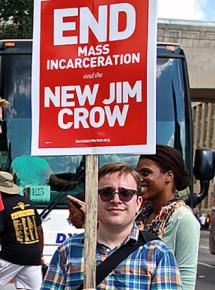Alternatives to punishment
reports on a Seattle-area meeting to discuss an alternative justice system.
NO NEW Jim Crow, a Seattle-area organization named after Michelle Alexander's groundbreaking book on mass incarceration, held a conference on "The Cultural Roots of Restorative Justice" on October 8-9 at the Tukwila Community Center.
Transformative and restorative justice (TJ/RJ) is a growing trend, with more schools using it instead of suspensions and other punishments. Some juvenile justice systems are also beginning to experiment with it, including Multnomah County near Portland, Oregon.
The idea behind transformative and restorative justice is that the person hurt and the person doing the harm can meet with school and/or community members to solve the dispute, and in some cases agree together on a course of action.
Some of the leaders in the movement to replace the punishment model with community problem solving were at the conference, including Fania Davis of the Restorative Justice for Oakland Youth; Morris Jenkins, dean of the College of Health and Human Services at Southeast Missouri State University; and three practitioners from New Zealand.

In New Zealand, the whole youth justice system is based on restorative justice rather than punishment. Their principle is not to arrest youth unless there is an acute dangerous situation, and not to bring them to trial except for the most serious crimes. This has resulted in a major drop in youth imprisonment.
The use of TJ/RJ can be an important part of the effort to lower imprisonment rates and to diminish the racism of the prison system. It has attracted significant support from anti-racist activists and critics of the prison system, including prison abolitionists.
The conference explored the cultural roots of this practice among the Maori in New Zealand, in African culture, among Asians and Native Americans and Europeans. There were also sessions on the school-to-prison pipeline, hip-hop and the crisis in communities of color.
THE INCREASED use of TJ/RJ is being driven largely by the rising anti-racist movement, but in some cases by those who are concerned about the high cost of high incarceration rates. The U.S. spends $80 billion on prisons, and even some people on the right want to cut this.
However, fiscal conservatives will only go so far in cutting prison population, since they support the punishment model overall. The need to divide people on racial lines is still a strong motivation driving mass incarceration, as is, secondarily, the economic interests of the prison-industrial complex. These interests will limit support to TJ/RJ from conservatives and even liberal politicians.
The conference itself was impressive. More than 150 registered, nearly half of them people of color and the majority female. Lots of young people attended, including many high school students.
The Sealth High School Black Student Union was represented, and talked about their recent protest at a football game that followed the national movement in support of Colin Kaepernick's protest for Black Lives Matter.
This conference was a step forward in the movement to use TJ/RJ instead of the punishment model. It was also a sign that more and more people are looking for radical alternatives to the current system of mass incarceration--and the other horrors that capitalism produces.


